DENON DJ PRIME GO
SETUP
Switch to Computer mode
When the Prime GO is powered on, it will be set to Standalone/Engine mode. To switch to Computer mode and control VirtualDJ you need to ...
- Hold down the VIEW button at the center panel of the device, or slide down the main screen.
- Tap on the Source button on the Prime GO screen.
- Tap on the Computer icon at the top of the Prime GO screen
Firmware & Drivers
Firmware : Update the firmware (Engine OS) of the unit to the latest available version from https://www.denondj.com/downloads
Drivers : (Windows only) Download and install the latest Windows drivers from https://www.denondj.com/downloads . It is strongly advised to install drivers prior plugging the unit to a USB computer port. The device's screen will not be operational if the driver is not installed.
Note: If Windows Driver fails to install, please look at https://support.inmusicstore.com/en/support/solutions/articles/69000832269-numark-mixstream-pro-driver-will-not-install
No driver is necessary to be installed on Mac OSX computers.
Note Due to Denon SDK incompatibility, the screens will be operational on Mac OSX 10.14 or later.,
VirtualDJ 8 Setup
Once VirtualDJ is opened, a Login Window will appear. Login with your virtualdj.com account’s credentials.
A Pro Infinity or a Pro Subscription License is required to use the Denon DJ Prime GO. Without any of the above Licenses, the controller will operate for 10 minutes each time you restart VirtualDJ.
https://www.virtualdj.com/buy/index.html
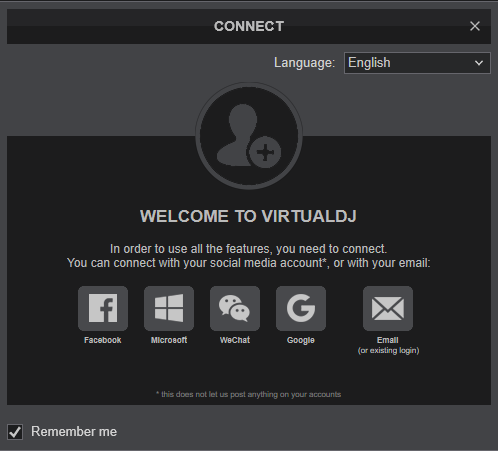
Select the Prime GO button in order VirtualDJ to apply the pre-defined audio configuration (speakers need to be connected to the rear side of the unit in this case), or Computer if you don't have any speakers to connect to the Prime GO and need to output sound from the default sound card of your computer.
Click to OK
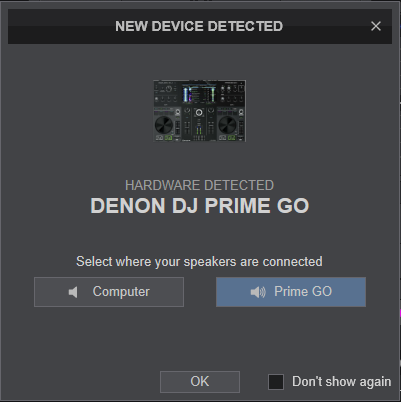
The unit is now ready to operate.
MIDI Operation
The unit should be visible in the MAPPING tab of VirtualDJ Settings and the “factory default” available/selected from the Mappings drop-down list.

The factory default Mapping offers the functions described in this Manual, however those can be adjusted to your needs via VDJ Script actions.
Find more details at https://www.virtualdj.com/wiki/VDJ8script.html
AUDIO Setup
The unit has a pre-defined Audio setup and a special button in the AUDIO tab of VirtualDJ Settings to provide that.
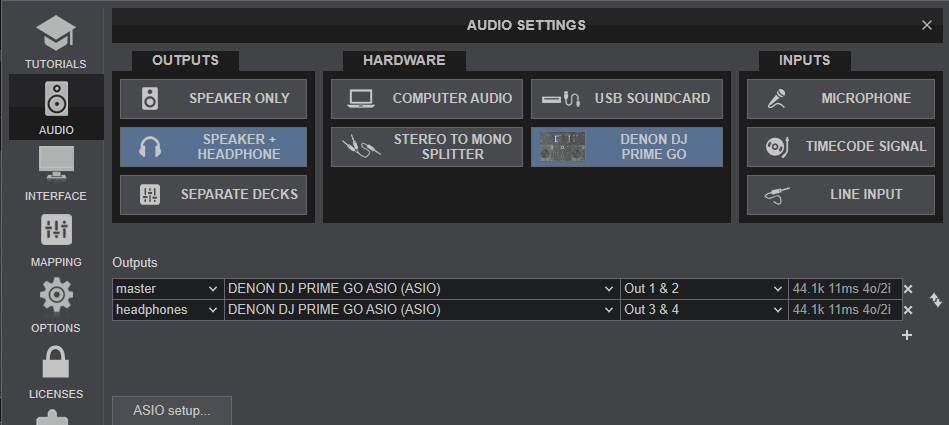
See also Inputs & Recording.
For further software settings please refer to the User Guide of VirtualDJ.
https://www.virtualdj.com/manuals/virtualdj/index.html
LAYOUT

The functionality of each button, knob and connection per section (as shown in the image above) will be explained in detail in the next chapters
S SHIFT: Press and hold this button to access secondary functions of other controls on the Prime GO
A Mixer & Browser Controls
B Deck Controls
C Pads
D Equalizer
E Effects
F Master & Microphone Controls
G Main Screen
H Front & Rear
MIXER & BROWSER CONTROLS

- CROSSFADER. Blends audio between the channels assigned to the left and right side of the crossfader.
- VOLUME. Volume Faders for Left/Right Mixer channel
- CUE/PFL. Use these buttons to send Left/Right channel's pre-fader signal to the Cue Channel for monitoring. When engaged, the buttons will be lit.
- SWEEP FX Use the buttons [1] or [2] to select a Color FX (High-Low Pass Filter by pressing the [1] button or the Echo Color FX by pressing the [2] button). Use the knob to apply the selected Color FX
- BACK : Sets focus to the Folders list of Browser. If focus is on Folders list, open/close sub-folders.
Hold SHIFT and then use this button to select the previous available list of Sideview (Automix, Sidelist, Karaoke, Sampler and Shortcuts) - FWD : Toggles Browser focus between Songs list and Sideview.
Hold SHIFT and then use this button to select the next available list of Sideview (Automix, Sidelist, Karaoke, Sampler and Shortcuts) - BROWSE : Scrolls through Files and Folders in the focused Browser list.
Hold SHIFT and then use this encoder to zoon in/out the Scratch Wave.
Push to cycle focus though the available Browser windows (Folders, Songs, Sideview)
Hold SHIFT down and then use this encoder to zoom in/out the vertical Scratchwave - LOAD : Loads the selected track from Browser to the Left/Right Deck.
Double-fast-press this button to clone the Track (and its position, tempo, playing status) from the other Deck to the called one.
Hold SHIFT down to unload the Deck - MENU : Toggles between Browser view (Large Browser - mini Decks) and Decks view on the Prime 2 screen.
Hold down for more than 1 second to open the Settings view on the Prime GO screen.
Hold SHIFT down and use this button to how/hide the Pads panel of the Prime GO screen. - MASTER VU METER Indicate the output level of the Master Output. Independent Hardware operation, not reflecting VirtualDJ Master VU Meter of VirtualDJ GUI
DECK CONTROLS

- PLAY. Plays / Pauses the track. Hold SHIFT down and then press this button to "stutter-play" the track from the last set Cue Point.
- CUE. When the Deck is paused, you can set a temporary Cue Point by moving the Platter to place the Audio Pointer at the desired location and then pressing the Cue Button.
During playback, you can press the Cue Button to return the track to this Cue Point. (If you did not set a Cue Point, then it will return to the beginning of the track.).
If the Deck is paused, you can press and hold the Cue Button to play the track from the Temporary Cue Point. Releasing the Cue Button will return the track to the temporary Cue Point and pause it.
To continue playback without returning to the Temporary Cue Point, press and hold the Cue Button, then press and hold the Play Button, and then release both buttons.
Press and hold SHIFT and then press this button to return to the beginning of the track. - PITCH BEND. Press and hold these buttons down to temporary speed up/slow down the song while pressed. When released, the track playback will return to the speed designated by the Pitch Fader.
Hold SHIFT down and then use this button to select the previous/next available % range of the Pitch Fader - PITCH. Adjust the track's playback speed (tempo).
- SYNC. Press this button to automatically match the corresponding Deck's tempo and phase with the opposite Deck's tempo and phase.
Hold SHIFT down and then use this button to smoothly reset Tempo to its original value.
Hold the same button down for more than 2 seconds to match the Key of the Deck to the value of the opposite Deck (key Sync). Repeat the same function to reset the Deck's Key to the original value. - LOOP AUTO. Turn this encoder left/right to half/double the size of the Loop in beats. Push the encoder to enable an auto-loop of the selected size in beats or push to exit the loop.
When Track is in Loop, hold SHIFT and then turn the encoder to move the loop backwards/forward by the same amount of the loop size in beats
When Track is not in Loop, hold SHIFT and then turn the encoder to move the Track backwards/forward by the same amount of the loop size in beats - JOG. Touch sensitive jogwheel. Use the jogwheel to scratch (if Vinyl mode is selected) or pitch bend.
Hold SHIFT and then use the Jogwheel to fast search through the track. - VINYL. Press this button to set the Jogwheel to Vinyl (Scratch) or CD (Bend) mode. In Vinyl mode, use the outer part of the Jogwheel to bend (temporary speed up – slow down the tempo of the track).
Hold SHIFT down and then press this button to turn Slip mode on/off. When enabled (led will blink), several actions such as scratching/holding Jog wheel, loops and hotcues will act temporarily and Track will resume to the position it would have been if this action was not performed.
Hold this button down for more than 2 seconds to enter Grid Edit mode (led will blink) and adjust the Beat-Grid of the loaded Track using the Jogwheel and the on-screen BPM edit buttons (see Screen). Press again to exit the Edit Grid mode
Pads
No content has been added for this category page yet..EQUALIZER CONTROLS

- LEVEL. Adjusts the audio level (gain) of the Left/Right Mixer channel.
- * EQ LOW. Use this knob to adjust the Low (bass) frequencies of the Left/Right mixer channel.
- * EQ MID. Use this knob to adjust the Middle (mid) frequencies of the Left/Right mixer channel.
- * EQ HIGH. Use this knob to adjust the High (treble) frequencies of the Left/Right mixer channel.
* Note The device is offering Full Stems controls. See details at EQ Modes
EFFECTS
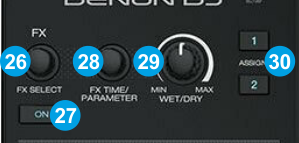
- FX SELECT. Turn left/right to select the previous/next available Effect.
Push to get a list of the available Effects on the Prime 2 screen UI, scroll to the desired effect and then push again to close the list.
The same Effect will be selected for both Left and Right Decks - FX ON. Press this button to enable/disable the selected effect to the assigned Deck(s)
- FX TIME/PARAMETER. Adjust the 2nd Parameter of the selected Effect, usually the Beats value.
Push the encoder and then turn to adjust the 3rd Parameter (if available). Push again to return to the control of the 2nd Parameter. - FX WET/DRY. Adjust the 1st Parameter of the selected Effect, usually the Strength value.
- FX ASSIGN Use these buttons to assign the selected Effect to the Left [1] and/or Right [2] Decks.

The name of the selected Effect, its status (on/off) and the Parameter values will be displayed on the Prime GO screen
MICROPHONE CONTROLS
The Denon DJ Prime GO offers 2 Microphone inputs (connections at the rear) and this section offers their controls.
Note that the both the Microphone Inputs are not part of the USB Audio interface, meaning that their signals are controlled and processed by the hardware, therefore their audio signal cannot be recorded along with the VirtualDJ mix.
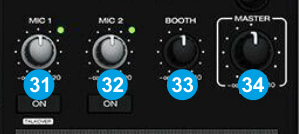
- MIC 1 LEVEL & ON : Adjust the output volume of Microphone 1 input. Press the ON button to turn on/off the Microphone 1 input.
- MIC 2 LEVEL & ON : Adjust the output volume of Microphone 2 input. Press the ON button to turn on/off the Microphone 2 input.
- BOOTH LEVEL : Adjust the volume of the Booth output (connection at the rear)
- MASTER LEVEL. Adjust the level of the Master Output. Hardware operation, but movement visible in VirtualDJ GUI.
Note : All the buttons and knobs of this section do not send MIDI and could not be mapped with a VDJ script action, as they perform hardware operation.
FRONT & REAR PANELS

- MASTER OUT (Balanced - XLR): Connect this low-impedance XLR output to a PA system or powered monitors. The level of this output is controlled with the Master Level knob on the top panel.
- MASTER OUT 2 (Unbalanced - RCA): Use standard RCA cables to connect this output to a speaker or amplifier system. The level of this output is controlled by the Master Level knob on the top panel.
- BOOTH OUT (XLR): Use TRS cables to connect this output to a booth monitoring system. The level of this output is controlled by the Booth Level knob on the top panel.
- AUX INPUT. Connect an auxiliary audio source to this input using standard RCA cable. The level of this input is controlled by the AUX level knob at the front panel. This input is not part of the USB Audio interface and its signal will be routed directly to the Master Output.
- MIC 1/2 Connect a microphone to these socket, using a 1/4" cable or XLR. The audio signals of these input is routed directly to the Program Mix and Cue Mix. The level of the Microphone Inputs is controlled from the top-right panel
These inputs are not part of the USB Audio interface and their signal will be routed directly to the Master Output. - USB B. Use the provided USB type B to type A cable to connect the unit with a USB port of a computer. This USB connection sends and receives audio and control information from a connected computer.
- USB MEDIA. Connect USB media devices in this USB port.
- LINK.Not used in VirtualDJ
- POWER IN & ON/OFF: Use the included AC/DC power adapter to connect Prime GO to a power outlet. While the power is switched off, plug the cable into unit first, and then plug the cable into a power outlet.
Use the Power Switch to turn the unit on and off. Turn on unit after all input devices have been connected and before you turn on amplifiers. Turn off amplifiers before you turn off unit
Denon DJ Prime GO - Front panel - HEADPHONES SOCKET. Connect your 1/4" or 1/8" headphones to this output for cueing and mix monitoring.
- CUE MIX Use this knob to blend Master Output signal with the Channels that have the CUE/PFL buttons enabled. When the knob is at the minimum position, only audio coming from the channels that have CUE/PFL enabled will be sent to Headphones. When in maximum position only audio signal from Master Output will be sent to the Headphones channel.
Independent Hardware operation, not controlling VirtualDJ Headphones Mix knob but its movement is visible on VirtualDJ GUI - CUE LEVEL Adjust the Volume of the Headphones Channel.
Independent Hardware operation, not controlling VirtualDJ Headphones Volume knob but its movement is visible on VirtualDJ GUI - AUX LEVEL. Adjusts the output volume of the AUX input (connection at the rear panel).
- SD CARD. Connect a SD media storage card
SCREEN
Prime GO has a fully functional and customize-able 7" touch-screen offering all the information needed for your mix. The default GUI for the screen will be automatically downloaded the first time you connect the Prime GO to a computer running VirtualDJ (Internet connection is required at least for the 1st time)
The default GUI of Prime GO offers a Decks view with the ability to hide the Pads section, and a Browser view with Large Browser and Mini Decks, along with a view for Settings.
Hold SHIFT down and then press the [VIEW] button on the Prime GO to show/hide the Pads section.
Use the VIEW button to toggle between the Decks view and the Browser view (with Mini Decks)
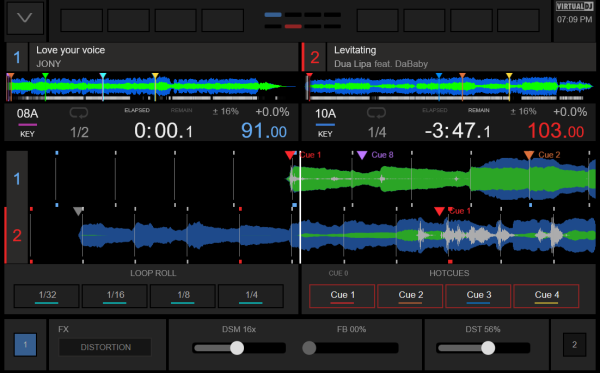

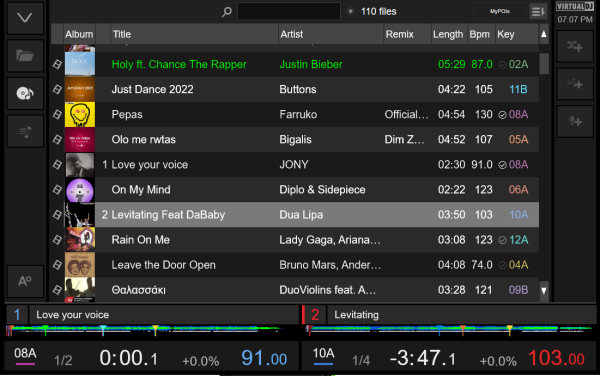
DECKS




Tap this area to get more key controls at the Deck info area.
BROWSER

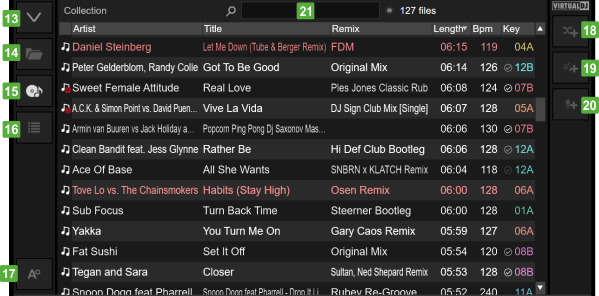
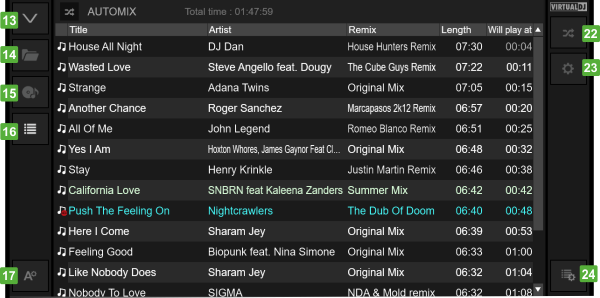
SETTINGS
Hold down the [VIEW] button for more than 2 seconds to get the SETTINGS view. Press the VIEW button again to go back to the Decks view.
Various settings are offered to adjust views, Waves, Browser behavior etc. and their values will be kept across sessions. A description of each setting is displayed at the bottom of the view, each time you tap, select or change a setting.
The Settings view will also offer a button to revert to Standalone mode, without exiting VirtualDJ.
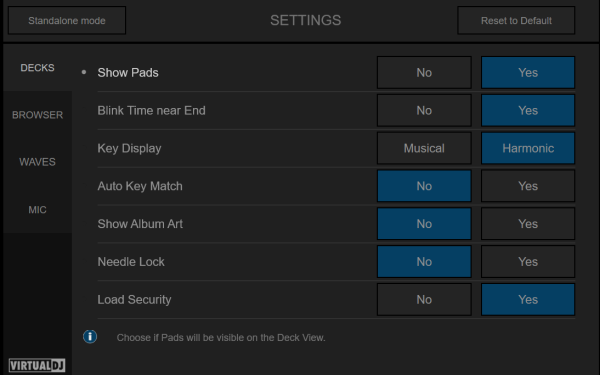
INPUTS & RECORDING
MICROPHONES
The Denon DJ Prime GO offers 2 Microphone inputs (connections at the rear panel) and various controls at the top-right panel for both of them. Both Microphone inputs are not part of the USB Audio Interface, and cannot be included in VirtualDJ Audio setup. None of the Mic controls of the device will control mic-related VDJ actions or GUI buttons and vice-versa.
AUX INPUT
The Prime GO offers an AUX Input (connection at the rear panel) and a AUX LEVEL knob at the top panel to control its level. This input is not part of the USB Audio Interface, so cannot be used in VirtualDJ Audio setup as Line Input or DVS (timecode) input. The signal of this Input will be directly routed to the Master/Booth output.
The signal of this input will be available (and heard to Master output) regardless the mode (Standalone or Engine) the Prime GO will be.
RECORD-BROADCAST
Your mix can be recorded with VirtualDJ, but without the signal of the 2 Microphone Inputs or the AUX input. A future firmware (Engine OS) update may offer a dedicated recording input to include both software Mix and hardware inputs.
STANDALONE MODE
The Denon Prime GO can operate either in Computer mode (using VirtualDJ or other supported DJ application), or in Standalone mode using the integrated Engine OS. However there is no back-to-back operation or an easy changeover between the 2 modes, as you will need to "close" one system first, before you "open" the other one.
A smooth transition between the 2 modes can be achieved though. While in Computer mode, you have the ability to connect an auxiliary audio/media source to the AUX Inputs and control its volume with the AUX Level knob at the top panel Then while this source is playing, you can switch from one mode to the other without notice.
